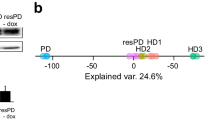Abstract
Understanding the molecular mechanisms of Parkinson’s disease (PD) is essential to development of therapeutic strategies. Despite many studies of the pathogenesis of PD, its exact mechanism is still unknown. Information on gene regulation in PD might provide an insight to PD pathogenesis. Time course gene expression data have been used to predict gene regulatory mechanisms in dynamic biological processes, such as development, drug response and the cell cycle. 1-Methyl-4-phenylpyridinium (MPP+), a dopaminergic neurotoxin, produces in vivo and in vitro cellular changes characteristic of PD that include cytotoxicity, which result in apoptosis. In this study, a time series microarray experiment was performed for MPP+ treated human neuroblastoma SH-EP cells. Prior to estimation of regulation structure, 997 MPP+ response genes were identified by the Extraction of Differential Gene Expression program. These MPP+ response genes were assigned to eight transcriptional modules including M 1±, M 2±, M 3±, and M 4± by a state space model and gene ontology analysis identified significantly enrich terms related to apoptosis signaling pathway in the three modules including M 1+, M 1− and M 3+. The regulation networks of MPP+ response genes were estimated using the auto-regressive form of the state space model. In the networks, four hub genes including CHAC1, MTHFD2, SH2D5 and LOC100134537 were identified. These hub genes showed direct or indirect positive feedback connection with genes, such as to AEN encoding apoptosis enhancing nuclease and ATF6 encoding a transcription factor that activates target genes for the unfolded protein response during ER stress. This network might provide an insight for interactions of mitochondrial dysfunction, endoplasmic reticulum stress and apoptosis in MPP+-induced model of PD.
Similar content being viewed by others
References
Foulds, P., Mann, D.M., Mitchell, J.D. & Allsop, D. Parkinson disease: Progress towards a molecular biomarker for Parkinson disease. Nat. Rev. Neurol. 6, 359–361 (2010).
Elbaz, A., Dufouil, C. & Alpérovitch, A. Interaction between genes and environment in neurodegenerative diseases. C. R. Biol. 330, 318–328 (2007).
Douglas, P.M. & Dillin, A. Protein homeostasis and aging in neurodegeneration. J. Cell Biol. 190, 719–729 (2010).
Bové, J. & Perier, C. Neurotoxin-based models of Parkinson’s disease. Neuroscience 211, 51–76 (2011).
Martinez, T.N. & Greenamyre, J.T. Toxin models of mitochondrial dysfunction in Parkinson’s disease. Antioxid. Redox Signal. 16, 920–934 (2012).
Spellman, P.T. et al. Comprehensive identification of cell cycle-regulated genes of the yeast Saccharomyces cerevisiae by microarray hybridization. Mol. Biol. Cell 9, 3273–3297 (1998).
Arbeitman, M.N. et al. Gene expression during the life cycle of Drosophila melanogaster. Science 297, 2270–2275 (2002).
Orlando, D.A. et al. A probabilistic model for cell cycle distributions in synchrony experiments. Cell Cycle 6, 478–488 (2007).
Hirose, O. et al. Statistical inference of transcriptional module-based gene networks from time course gene expression profiles by using state space models. Bioinformatics 24, 932–942.
Leek, J.T., Monsen, E., Dabney, A.R. & Storey, J.D. EDGE: extraction and analysis of differential gene expression. Bioinformatics 22, 507–508 (2006).
Eden, E., Navon, R., Steinfeld, I., Lipson, D. & Yakhini, Z. GOrilla: a tool for discovery and visualization of enriched GO terms in ranked gene list. BMC Bioinformatics 10, 48 (2009).
Shumway, R.H. & Stoffer, D.S. An approach to time series smoothing and forecasting using the EM algorithm. J. Time Series Anal. 3, 253–264 (1982).
Arnone, M.I. & Davidson, E.H. The hardwiring of development: organization and function of genomic regulatory systems. Development 124, 1851–1864 (1997).
Pike, S.T., Rajendra, R., Artzt, K. & Appling, D.R. Mitochondrial C1-tetrahydrofolate synthase (MTHFD1L) supports the flow of mitochondrial one-carbon units into the methyl cycle in embryos. J. Biol. Chem. 285, 4612–4620 (2010).
Brandman, O., Ferrell, J.E. Jr., Li, R. & Meyer, T. Interlinked fast and slow positive feedback loops drive reliable cell decisions. Science 310, 496–498 (2005).
Pomerening, J.R., Kim, S.Y. & Ferrell, J.E. Jr. Systemslevel dissection of the cell-cycle oscillator: bypassing positive feedback produces damped oscillations. Cell 122, 565–578 (2005).
Ferrell, J.E. Jr. & Machleder, E.M. The biochemical basis of an all-or-none cell fate switch in Xenopus oocytes. Science 280, 895–898 (1998).
Choia, H.-S., Hanb, S., Yokotac, H. & Chob, K.-H. Coupled positive feedbacks provoke slow induction plus fast switching in apoptosis. FEBS Letters 581, 2684–2690 (2007).
Yokoyama, H., Kuroiwa, H., Yano, R. & Araki, T. Targeting reactive oxygen species, reactive nitrogen species and inflammation in MPTP neurotoxicity and Parkinson’s disease. Neurol. Sci. 29, 293–301 (2008).
Marciniak, S.J. et al. CHOP induces death by promoting protein synthesis and oxidation in the stressed endoplasmic reticulum. Genes Dev. 18, 3066–3077 (2004).
Timmins, J.M. et al. Calcium/calmodulin-dependent protein kinase II links ER stress with Fas and mitochondrial apoptosis pathways. J. Clin. Invest. 119, 2925–2941 (2009).
Do, J.H., Yamaguchi, R. & Miyano, S. Exploring temporal transcription regulation structure of Aspergillus fumigatus in heat shock by state space model. BMC Genomics 10, 306 (2009).
Author information
Authors and Affiliations
Corresponding author
Rights and permissions
About this article
Cite this article
Do, J.H. Transcriptional regulation analysis in a neurotoxin-induced apoptosis of human neuroblastoma SH-EP cells with a state space model. BioChip J 8, 137–147 (2014). https://doi.org/10.1007/s13206-014-8209-9
Received:
Accepted:
Published:
Issue Date:
DOI: https://doi.org/10.1007/s13206-014-8209-9



